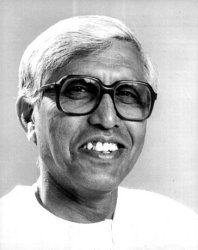 |
  |
 |
  |
The passing of a great soul: nattuvunar and teacher Guru K N Dakshinamoorthy Pillai A dedication by Nalini Rau, New York e-mail: damodara_lakshmi@jpmorgan.com April 29, 2005  Guru K N Dakshinamoorthy Pillai, the great nattuvunar, teacher, choreographer and percussionist and the keeper of the Dandayudapani Pillai Bani tradition, passed away on the night of April 25th. He was 77 years old. During his lifetime, he trained several hundred students in the art of Bharatanatyam, conducted hundreds of performances, and inspired many of his students to dedicate their lives to the art. A true Guru, he saw the hidden potential in the dancer and strived hard with his choreography and nattuvangam to bring it out. With reverence, he preserved and passed on to his students, the lineage and work of his older brother, the legendary Guru K N Dandayudapani Pillai. His nattuvangam was impeccable, and brought tremendous life and beauty in each performance he conducted, whether it was the performance of a student performing her debut or of seasoned artists such as Yamini Krishnamoorthy and Sonal Mansingh. Born on July 26th, 1928, Guru Karaikkal Natesha Dakshinamoorthy Pillai hails from a family of Natya Vidwans and musicians, who for generations have kept alive the tradition of dance, percussion and nattuvangam. His father Natesha, was a vocalist, and his grand-uncle Ramakrishnan, a nattuvanar for the Sani temple at Tirunallar. Guruji trained as a percussionist from an early age. He gave his first solo mridangam recital at the temple as an 18 year old. His brother Dandayudapani Pillai, inspired and influenced him tremendously. He studied with him, playing the mridangam as part of the orchestra, learning the art of nattuvangam and the compositions and choreography of the art form. The family made the decision to open three branches of Natyakalalayam, with Guru K N Dandayudapani Pillai in Madras, Guru K N Pakkiriswamy in Bombay and Guru Dakshinamoorthy Pillai moving to Delhi. He moved to Delhi in 1953. A southerner in the north, he faced the challenges of overcoming linguistic and cultural barriers in teaching Bharatanatyam. He evolved his teaching style to teach dancers of different linguistic backgrounds. He choreographed new items in Indo-Aryan and Dravidian languages. He composed and choreographed melapraptis, padams, nrityavandanas and thillanas. He composed hundreds of new jathis. His jathis were known for their shape, energy and clarity. He choreographed them in the style, which has now come to be established as the Dandayudapani Pillai Bani. Guru Dakshinamoorthy Pillai received the Kalaimamani award from the Tamil Nadu Government in 1985. He received the Sahitya Kala Parishad award in 1992. He served on the Doordarshan Panel, and the Department of Culture's Dance Evaluation Panel. His health was failing rapidly in the last five years. A man of tremendous inner strength and zeal, he overcame his ailments to be chief guest during the annual festival of Kartik Fine Arts in the winter of 2003 at the performance of this author's daughter, Rohini. His dignity and love for the art shone through his frail frame as he spoke to the packed audience. It was his last public appearance. His students around the world are continuing his legacy of totally dedicating themselves to classical dance, notable among them are: Anjana Banerjee in Calcutta, Geeta Chandran in Delhi, Ann Marie Gaston in Canada, Taeko Kurakawa in Japan, Tarveen Mehra, Charu Narasimhan in Washington D C, Nalini Rau in New York, Pushkala Gopal in London and Swapna Sundari. Several artists, such as Usha Srinivasan and Hema Rajagopal were trained under Guru Dandayudapani Pillai, and furthered their training with Guru Dakshinamoorthy Pillai. K J Govindarajan's students, such as Sindhu Bhagia-Mishra, M Chawla continued their training with Guruji. He is survived by his sons Balaji, Nalin, and daughters Amrita, Varshini and Veenu, their families, and his nieces Uma Dandayudapani Pillai and Kalyani Shekar. His daughter Veenu in Chennai, hopes to continue the family's intimate association with the performing arts. At a very personal level, he initiated me into Bharatanatyam, taught and inspired me from when I was about eight or nine till I was twenty four. He was a demanding, fierce yet loving teacher. He gave of himself tirelessly, and taught generously. He charged minimally from those who could not afford higher fees, and threw himself into every aspect of a recital. The practice sessions for performances were long and exhilarating. His days were packed with his teaching and performances. For instance, in the early eighties, he would teach me in the morning from 5 to 7.30 am, and would later teach a group lesson for three hours in the evening, with many other classes all over town. By mid-eighties, he had students come home for classes, with his wife Naga often offering vocal support and valuable insights on abhinaya to the students. Much like a father, he watched anxiously as I battled with a back injury to walk and then slowly dance again. In joy on seeing me dance again, he taught me tirelessly from 9 in the morning till 7 at night in a week long training session in 1994, trying to make up for the lost years, and give as much of himself as he could before I went back to the US. He extended this love to all who were willing to learn and who came to him with respect. Later, when I asked his permission to learn from Guru U S Krishna Rao, as he himself could not teach me, he gave it. He later listened critically as I described to him what I was trying to create far from all that had nurtured me. He gave of himself unconditionally. Much as I would dearly have liked to do another bhoomi namaskar in his presence, I know he is at peace, his mission accomplished. Nalini Rau is the director of Natya Anubhava. She is a performer, teacher and choreographer of Bharatanatyam and resides in New York. |